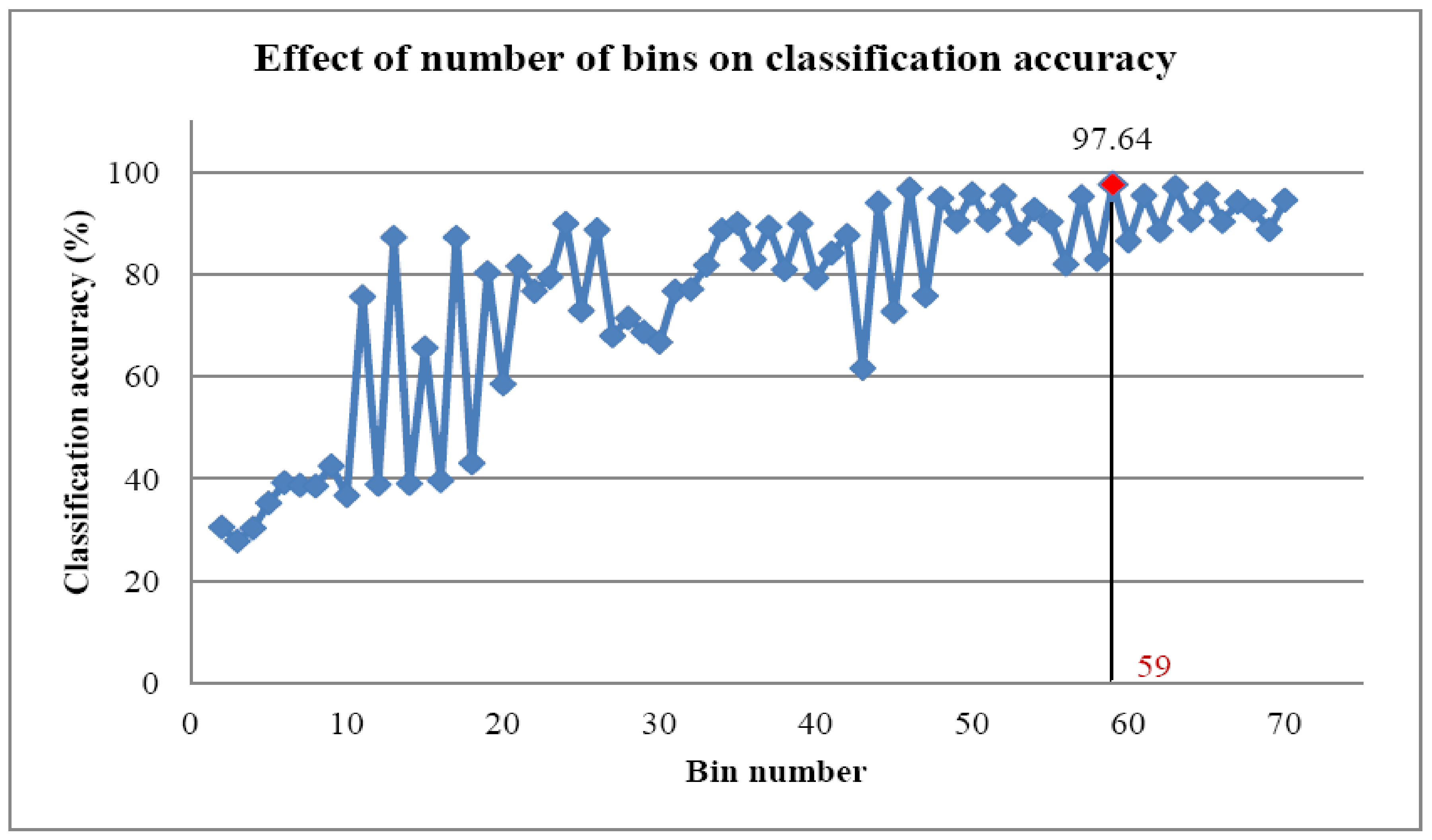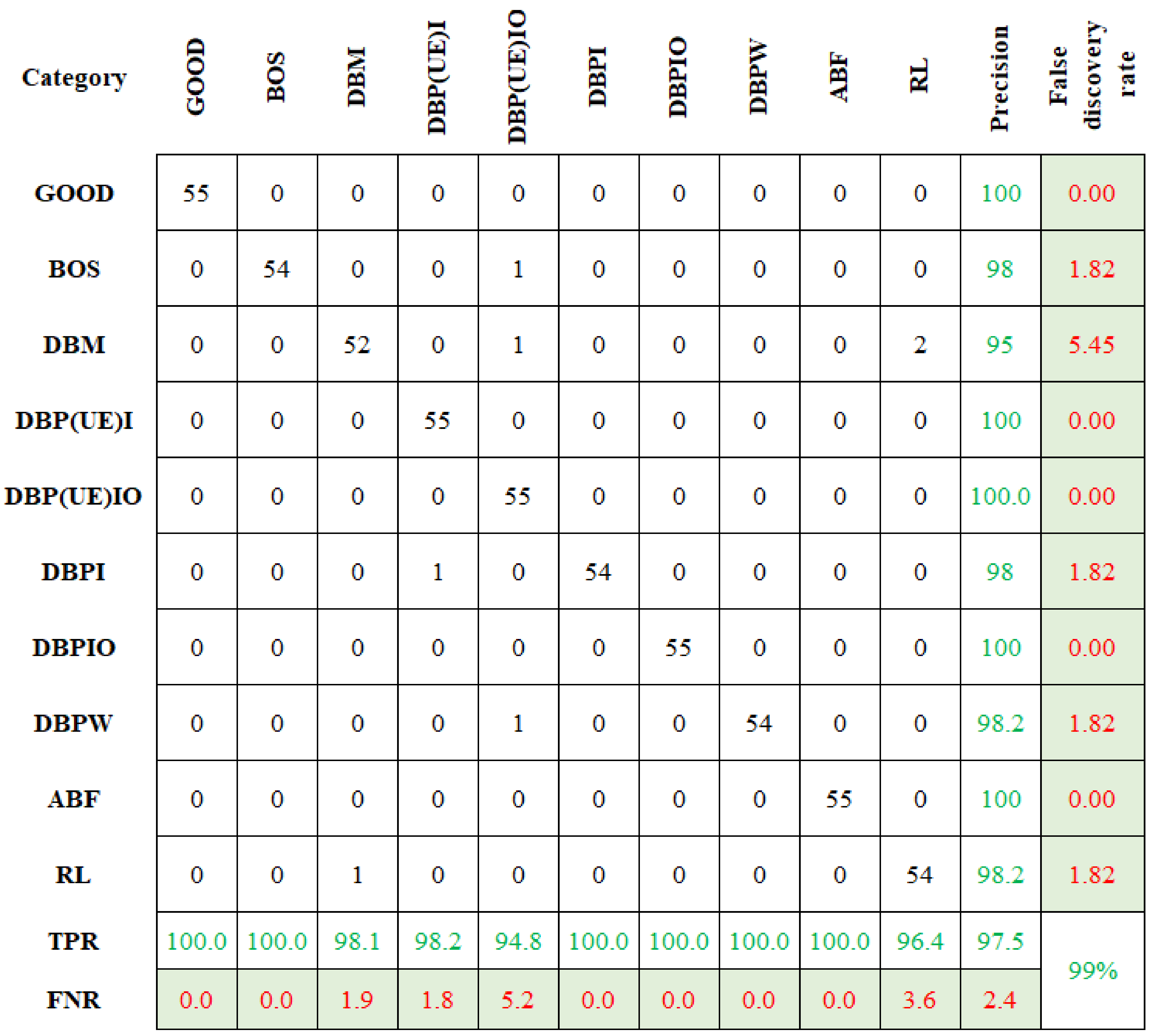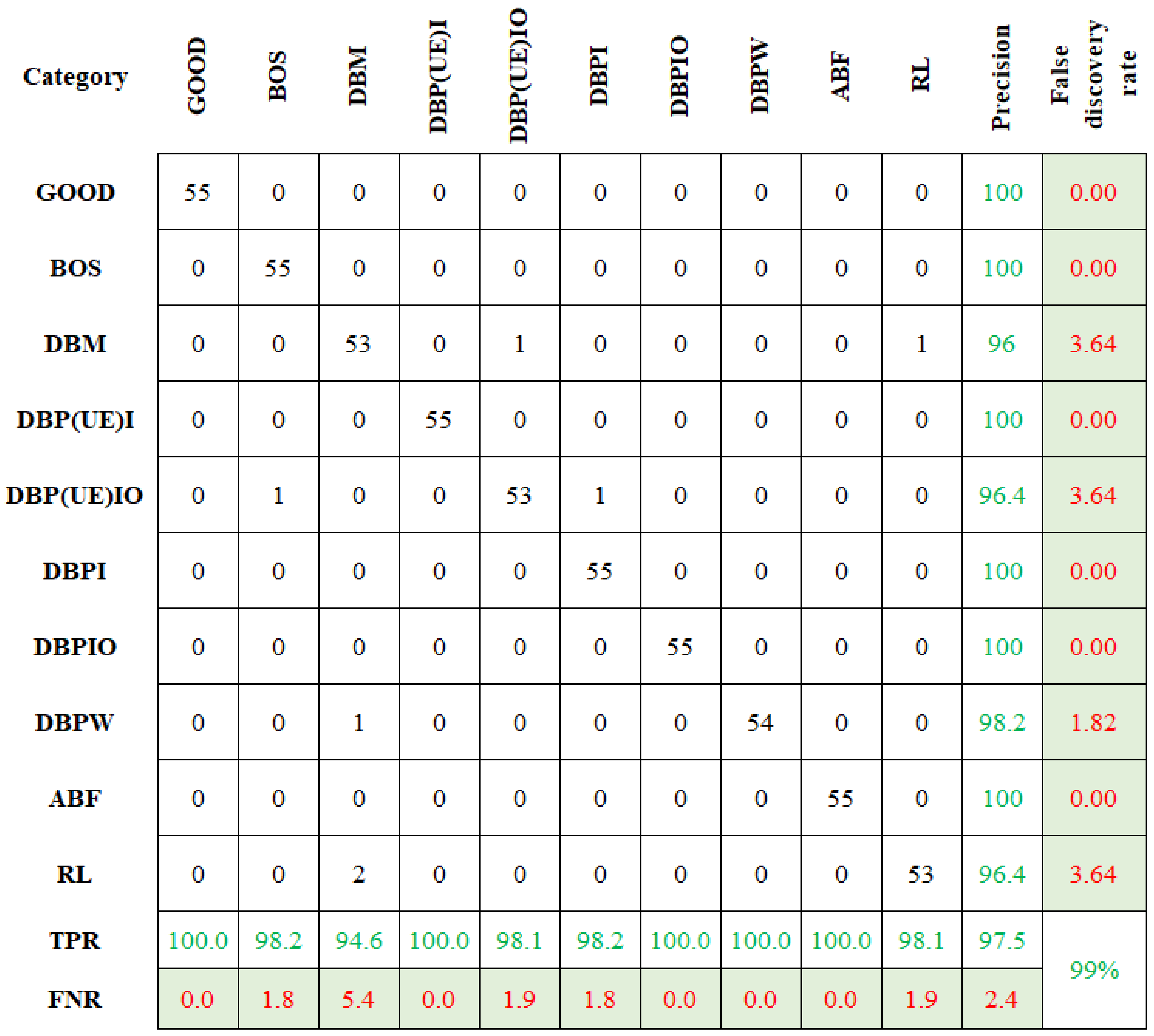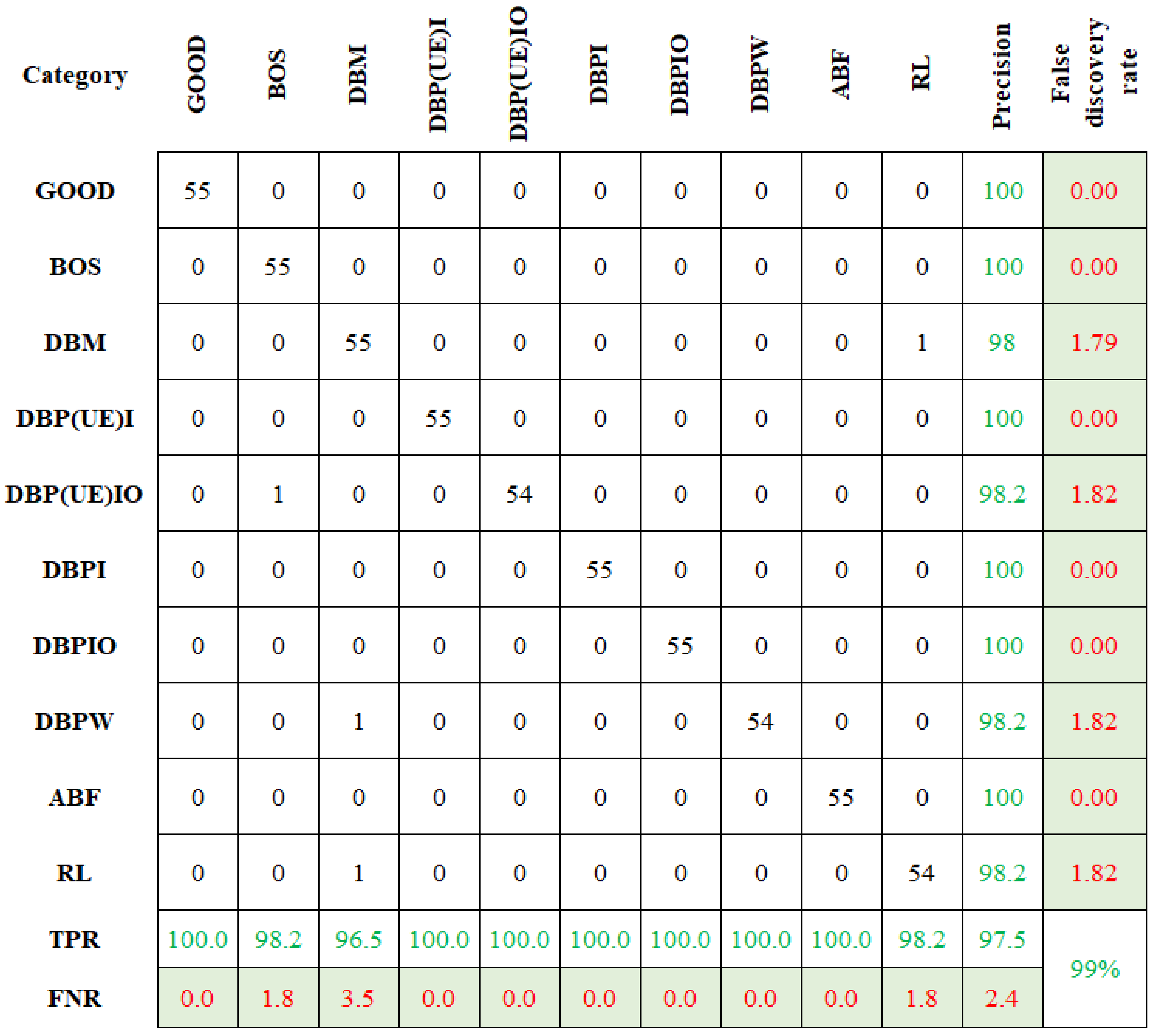A Comprehensive Approach for Detecting Brake Pad Defects Using Histogram and Wavelet Features with Nested Dichotomy Family Classifiers
Abstract
:1. Introduction
2. Experimental Procedure
2.1. Experimental Test Rig
2.2. Experimental Procedure
- ➢
- Sample length and no. of samples: 213 and 55 (arbitrarily chosen);
- ➢
- Sampling frequency: 24 kHz (as per the Nyquist sampling theorem);
- ➢
- Wheel speed and brake force: 331 rpm (~30 KMPH) and 68.7 N.

3. Histogram Features
- Compute the least magnitude of each signal in a specific condition;
- Repetition of step (i) for all conditions;
- Identify the least of those least magnitudes.
4. Wavelet Filter
4.1. Wavelet Transform
4.2. Discrete Wavelet Transform
- Haar—‘haar’;
- Daubechies—‘db’;
- Symlet—‘sym’;
- Coiflets—‘coif’;
- Biorthogonal—‘bior’;
- Reverse biorthogonal—‘rbio’;
- Discrete approximation of Meyer—‘dmey’;
- Fejer–korovkin—‘fk’.
5. Feature Selection
6. Feature Classification
7. Results and Discussion
7.1. Histogram Feature Classification Using Nested Dichotomy Family Classifiers
- Random no. seed: 1;
- No. of trees: 10;
- Base learner: best first tree;
- Tree depth: unlimited.


7.2. Wavelet Feature Classification Using ND Family Classifiers
7.3. Comprehensive Accuracy by Condition
7.4. Comparative Analysis
8. Conclusions
Author Contributions
Funding
Institutional Review Board Statement
Informed Consent Statement
Data Availability Statement
Acknowledgments
Conflicts of Interest
References
- National Highway Traffic Safety Administration. Critical Reasons for Crashes Investigated in the National Motor Vehicle Crash Causation Survey; US Department of Transportation: Washington, DC, USA, 2015; Volume 2, pp. 1–2.
- NickJohnson. Brake Failure Accidents. 2007. Available online: www.articles3k.com/article/144/176520 (accessed on 1 September 2023).
- Mohapatra, A.G.; Mohanty, A.; Pradhan, N.R.; Mohanty, S.N.; Gupta, D.; Alharbi, M.; Alkhayyat, A.; Khanna, A. An Industry 4.0 implementation of a condition monitoring system and IoT-enabled predictive maintenance scheme for diesel generators. Alex. Eng. J. 2023, 76, 525–541. [Google Scholar] [CrossRef]
- Molla Salilew, W.; Karim, Z.A.A.; Lemma, T.A. Investigation of fault detection and isolation accuracy of different Machine learning techniques with different data processing methods for gas turbine. Alex. Eng. J. 2022, 61, 12635–12651. [Google Scholar] [CrossRef]
- Goel, S.; Ghosh, R.; Kumar, S.; Akula, A. A methodical review of condition monitoring techniques for electrical equipment. In Proceedings of the National Seminar & Exhibition on Non-Destructive Evaluation (NDE 2014), Pune, India, 4–6 December 2014. [Google Scholar]
- Wallace, T.E.; Rink, R.J.; Chandler, M.D. Brake Monitoring System and Method. US Patent No. 8,319,623, 27 November 2012. [Google Scholar]
- Kanda, Y.; Terashima, N.; Katou, T. Vehicle Condition Monitoring System. US Patent No. 7,321,814, 22 January 2008. [Google Scholar]
- Fiechter, C.-N.; Göker, M.H.; Grill, D.; Kaufmann, R.; Engelhardt, T.; Bertsche, A. Method and System for Condition Monitoring of Vehicles. US Patent No. 6,609,051, 19 August 2003. [Google Scholar]
- Haugse, E.D.; Ikegami, R.; Trego, A. Vehicle Condition Monitoring System. US Patent No. 6,691,007, 10 February 2004. [Google Scholar]
- Miller, R.J.; Marshall, R.J.; Bailey, D.A.; Griffin, N.C. Brake Condition Monitoring. US Patent No. 7,086,503, 3 August 2001. [Google Scholar]
- Praveenkumar, T.; Saimurugan, M.; Ramachandran, K. Intelligent Fault Diagnosis of Synchromesh Gearbox Using Fusion of Vibration and Acoustic Emission Signals for Performance Enhancement. Int. J. Progn. Health Manag. 2019, 10, 2738. [Google Scholar] [CrossRef]
- Yuvaraju, E.; Rudresh, L.; Saimurugan, M. Vibration signals based fault severity estimation of a shaft using machine learning techniques. Mater. Today Proc. 2020, 24, 241–250. [Google Scholar] [CrossRef]
- Kim, Y.; Lee, S.; Seo, H.; Jung, J.; Yang, H. Development of dissolved gas analysis (DGA) expert system using new diagnostic algorithm for oil-immersed transformers. In Proceedings of the 2012 IEEE International Conference on Condition Monitoring and Diagnosis, Bali, Indonesia, 23–27 September 2012; pp. 365–369. [Google Scholar] [CrossRef]
- Sreedhar, U.; Krishnamurthy, C.; Balasubramaniam, K.; Raghupathy, V.; Ravisankar, S. Automatic defect identification using thermal image analysis for online weld quality monitoring. J. Mater. Process. Technol. 2012, 212, 1557–1566. [Google Scholar] [CrossRef]
- Sachin Krishnan, P.; Rameshkumar, K.; Krishnakumar, P. Hidden Markov modelling of high-speed milling (HSM) process using acoustic emission (AE) signature for predicting tool conditions. In Advances in Materials and Manufacturing Engineering; Springer: Singapore, 2020; pp. 573–580. [Google Scholar]
- Elasha, F.; Greaves, M.; Mba, D.; Addali, A. Application of acoustic emission in diagnostic of bearing faults within a helicopter gearbox. Procedia Cirp 2015, 38, 30–36. [Google Scholar] [CrossRef]
- Tan, C.K.; Irving, P.; Mba, D. A comparative experimental study on the diagnostic and prognostic capabilities of acoustics emission, vibration and spectrometric oil analysis for spur gears. Mech. Syst. Signal Process. 2007, 21, 208–233. [Google Scholar] [CrossRef]
- Altaf, M.; Akram, T.; Khan, M.A.; Iqbal, M.; Ch, M.M.I.; Hsu, C.-H. A New Statistical Features Based Approach for Bearing Fault Diagnosis Using Vibration Signals. Sensors 2022, 22, 2012. [Google Scholar] [CrossRef] [PubMed]
- Gnanasekaran, S.; Jakkamputi, L.; Thangamuthu, M.; Marikkannan, S.K.; Rakkiyannan, J.; Thangavelu, K.; Kotha, G. Condition Monitoring of an All-Terrain Vehicle Gear Train Assembly Using Deep Learning Algorithms with Vibration Signals. Appl. Sci. 2022, 12, 10917. [Google Scholar] [CrossRef]
- Mohanraj, T.; Yerchuru, J.; Krishnan, H.; Aravind, R.N.; Yameni, R. Development of tool condition monitoring system in end milling process using wavelet features and Hoelder’s exponent with machine learning algorithms. Measurement 2021, 173, 108671. [Google Scholar] [CrossRef]
- Steffan, J.J.; Jebadurai, I.J.; Asirvatham, L.G.; Manova, S.; Larkins, J.P. Prediction of Brake Pad Wear Using Various Machine Learning Algorithms. In Recent Trends in Design, Materials and Manufacturing; Springer: Singapore, 2022; pp. 529–543. [Google Scholar]
- Liu, J.; Li, Y.-F.; Zio, E. A SVM framework for fault detection of the braking system in a high speed train. Mech. Syst. Signal Process. 2017, 87, 401–409. [Google Scholar] [CrossRef]
- Joshuva, A.; Anaimuthu, S.; Selvaraju, N.; Muthiya, S.J.; Subramaniam, M. A Machine Learning Approach for Vibration Signal Based Fault Classification on Hydraulic Braking System through C4. 5 Decision Tree Classifier and Logistic Model Tree Classifier; SAE Technical Paper; SAE International: Warrendale, PA, USA, 2020. [Google Scholar] [CrossRef]
- Satapathy, S.; Loganathan, D.; Kondaveeti, H.K.; Rath, R. Performance analysis of machine learning algorithms on automated sleep staging feature sets. CAAI Trans. Intell. Technol. 2021, 6, 155–174. [Google Scholar] [CrossRef]
- Mazzoleni, M.; Sarda, K.; Acernese, A.; Russo, L.; Manfredi, L.; Glielmo, L.; Del Vecchio, C. A fuzzy logic-based approach for fault diagnosis and condition monitoring of industry 4.0 manufacturing processes. Eng. Appl. Artif. Intell. 2022, 115, 105317. [Google Scholar] [CrossRef]
- Bajaj, N.S.; Patange, A.D.; Jegadeeshwaran, R.; Kulkarni, K.A.; Ghatpande, R.S.; Kapadnis, A.M. A Bayesian optimized discriminant analysis model for condition monitoring of face milling cutter using vibration datasets. J. Nondestruct. Eval. Diagn. Progn. Eng. Syst. 2022, 5, 021002. [Google Scholar] [CrossRef]
- Vos, K.; Peng, Z.; Jenkins, C.; Shahriar, M.R.; Borghesani, P.; Wang, W. Vibration-based anomaly detection using LSTM/SVM approaches. Mech. Syst. Signal Process. 2022, 169, 108752. [Google Scholar] [CrossRef]
- Chao, Q.; Wei, X.; Tao, J.; Liu, C.; Wang, Y. Cavitation recognition of axial piston pumps in noisy environment based on Grad-CAM visualization technique. CAAI Trans. Intell. Technol. 2023, 8, 206–218. [Google Scholar] [CrossRef]
- Jia, Y.; Xu, M.; Wang, R. Symbolic important point perceptually and hidden Markov model based hydraulic pump fault diagnosis method. Sensors 2018, 18, 4460. [Google Scholar] [CrossRef] [PubMed]
- Wang, Y.; Yan, Y.; Wang, Q. Wavelet-based feature extraction in fault diagnosis for biquad high-pass filter circuit. Math. Probl. Eng. 2016, 2016, 5682847. [Google Scholar] [CrossRef]
- Yao, Y.; Ma, J.; Ye, Y. Regularizing Autoencoders with Wavelet Transform for Sequence Anomaly Detection. Pattern Recognit. 2022, 134, 109084. [Google Scholar] [CrossRef]
- Leathart, T.; Frank, E.; Pfahringer, B.; Holmes, G. Ensembles of nested dichotomies with multiple subset evaluation. In Proceedings of the Pacific-Asia Conference on Knowledge Discovery and Data Mining, Macau, China, 14–17 April 2019. [Google Scholar]











| No. of Features | Categorization Accuracy (%) | ||
|---|---|---|---|
| ND | CBND | DNBND | |
| 1 | 28.91 | 28 | 28.36 |
| 2 | 89.45 | 88.55 | 90 |
| 3 | 96 | 95.27 | 95.82 |
| 4 | 94.55 | 94.91 | 95.27 |
| 5 | 98 | 98.73 | 98.55 |
| 6 | 98 | 99.27 | 98.73 |
| 7 | 98.73 | 98.55 | 98.73 |
| 8 | 98.73 | 99.45 | 99.27 |
| 9 | 98.55 | 99.27 | 98.91 |
| Wavelet | Classification Accuracy (%) | ||
|---|---|---|---|
| ND | CBND | DNBND | |
| Coif1L5 | 98.73 | 99.45 | 99.27 |
| Dmey | 99.27 | 99.09 | 99.09 |
| Bior2.2L5 | 98.18 | 98.18 | 98.36 |
| Db5L5 | 99.09 | 98.73 | 98.36 |
| Haar | 98.73 | 98.55 | 98.55 |
| Sym3L5 | 98.73 | 98.55 | 98.55 |
| Rbior2.8L5 | 86.73 | 85.82 | 86 |
| Fk4L5 | 97.64 | 98.18 | 98.36 |
| Classifier | Features | Total No. of Data | Correctly Categorized Instances | Incorrectly Categorized Instances | Kappa Statistic | ||
|---|---|---|---|---|---|---|---|
| ND | Histogram | 550 | 540 | 98.18% | 10 | 1.82% | 0.9758 |
| CBND | Histogram | 550 | 542 | 98.55% | 8 | 1.45% | 0.9818 |
| DNBND | Histogram | 550 | 542 | 98.55% | 8 | 1.45% | 0.9818 |
| ND | Coiflets wavelet | 550 | 543 | 98.73% | 7 | 1.27% | 0.9859 |
| CBND | Coiflets wavelet | 550 | 547 | 99.45% | 3 | 0.55% | 0.9939 |
| DNBND | Coiflets wavelet | 550 | 546 | 99.27% | 4 | 0.73% | 0.9919 |
| Category | TPR | FPR | Precision | Recall | F-Measure | ROC Area |
|---|---|---|---|---|---|---|
| ABF | 1 | 0 | 1 | 1 | 1 | 1 |
| BOS | 1 | 0.002 | 0.982 | 1 | 0.991 | 1 |
| DBM | 1 | 0.004 | 0.965 | 1 | 0.982 | 1 |
| DBP(UE) inner | 1 | 0 | 1 | 1 | 1 | 1 |
| DB(UE) IO | 0.982 | 0 | 1 | 0.982 | 0.991 | 1 |
| DBPI | 1 | 0 | 1 | 1 | 1 | 1 |
| DBPIO | 1 | 0 | 1 | 1 | 1 | 1 |
| DBPW | 0.982 | 0 | 1 | 0.982 | 0.991 | 1 |
| GOOD | 1 | 0 | 1 | 1 | 1 | 1 |
| RL | 0.982 | 0 | 1 | 0.982 | 0.991 | 1 |
| Weighted Average | 0.995 | 0.001 | 0.995 | 0.995 | 0.995 | 1 |
| S. No. | Name of the Classifier | Classification Accuracy (%) | |
|---|---|---|---|
| Wavelet Features | Histogram Features | ||
| 1 | ND | 99.20 | 97.50 |
| 2 | CBND | 99.45 | 97.00 |
| 3 | DNBND | 99.30 | 99.00 |
Disclaimer/Publisher’s Note: The statements, opinions and data contained in all publications are solely those of the individual author(s) and contributor(s) and not of MDPI and/or the editor(s). MDPI and/or the editor(s) disclaim responsibility for any injury to people or property resulting from any ideas, methods, instructions or products referred to in the content. |
© 2023 by the authors. Licensee MDPI, Basel, Switzerland. This article is an open access article distributed under the terms and conditions of the Creative Commons Attribution (CC BY) license (https://creativecommons.org/licenses/by/4.0/).
Share and Cite
Gnanasekaran, S.; Jakkamputi, L.P.; Rakkiyannan, J.; Thangamuthu, M.; Bhalerao, Y. A Comprehensive Approach for Detecting Brake Pad Defects Using Histogram and Wavelet Features with Nested Dichotomy Family Classifiers. Sensors 2023, 23, 9093. https://doi.org/10.3390/s23229093
Gnanasekaran S, Jakkamputi LP, Rakkiyannan J, Thangamuthu M, Bhalerao Y. A Comprehensive Approach for Detecting Brake Pad Defects Using Histogram and Wavelet Features with Nested Dichotomy Family Classifiers. Sensors. 2023; 23(22):9093. https://doi.org/10.3390/s23229093
Chicago/Turabian StyleGnanasekaran, Sakthivel, Lakshmi Pathi Jakkamputi, Jegadeeshwaran Rakkiyannan, Mohanraj Thangamuthu, and Yogesh Bhalerao. 2023. "A Comprehensive Approach for Detecting Brake Pad Defects Using Histogram and Wavelet Features with Nested Dichotomy Family Classifiers" Sensors 23, no. 22: 9093. https://doi.org/10.3390/s23229093
APA StyleGnanasekaran, S., Jakkamputi, L. P., Rakkiyannan, J., Thangamuthu, M., & Bhalerao, Y. (2023). A Comprehensive Approach for Detecting Brake Pad Defects Using Histogram and Wavelet Features with Nested Dichotomy Family Classifiers. Sensors, 23(22), 9093. https://doi.org/10.3390/s23229093









